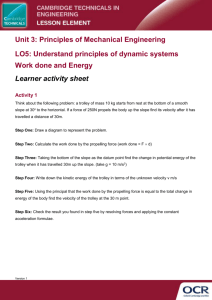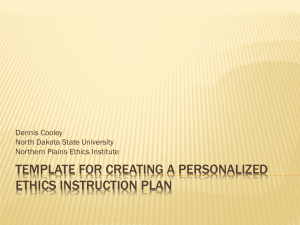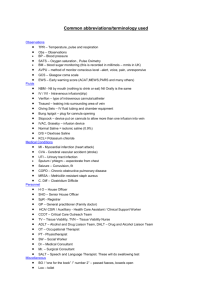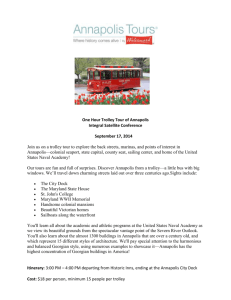TheTrolleyProblem
advertisement
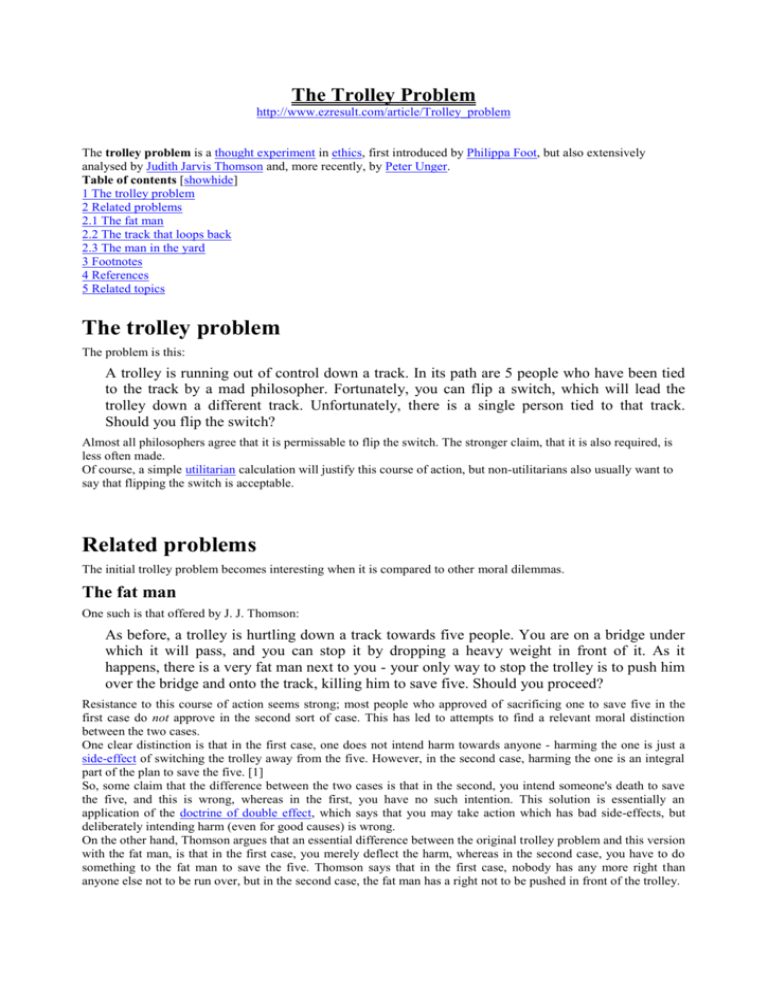
The Trolley Problem http://www.ezresult.com/article/Trolley_problem The trolley problem is a thought experiment in ethics, first introduced by Philippa Foot, but also extensively analysed by Judith Jarvis Thomson and, more recently, by Peter Unger. Table of contents [showhide] 1 The trolley problem 2 Related problems 2.1 The fat man 2.2 The track that loops back 2.3 The man in the yard 3 Footnotes 4 References 5 Related topics The trolley problem The problem is this: A trolley is running out of control down a track. In its path are 5 people who have been tied to the track by a mad philosopher. Fortunately, you can flip a switch, which will lead the trolley down a different track. Unfortunately, there is a single person tied to that track. Should you flip the switch? Almost all philosophers agree that it is permissable to flip the switch. The stronger claim, that it is also required, is less often made. Of course, a simple utilitarian calculation will justify this course of action, but non-utilitarians also usually want to say that flipping the switch is acceptable. Related problems The initial trolley problem becomes interesting when it is compared to other moral dilemmas. The fat man One such is that offered by J. J. Thomson: As before, a trolley is hurtling down a track towards five people. You are on a bridge under which it will pass, and you can stop it by dropping a heavy weight in front of it. As it happens, there is a very fat man next to you - your only way to stop the trolley is to push him over the bridge and onto the track, killing him to save five. Should you proceed? Resistance to this course of action seems strong; most people who approved of sacrificing one to save five in the first case do not approve in the second sort of case. This has led to attempts to find a relevant moral distinction between the two cases. One clear distinction is that in the first case, one does not intend harm towards anyone - harming the one is just a side-effect of switching the trolley away from the five. However, in the second case, harming the one is an integral part of the plan to save the five. [1] So, some claim that the difference between the two cases is that in the second, you intend someone's death to save the five, and this is wrong, whereas in the first, you have no such intention. This solution is essentially an application of the doctrine of double effect, which says that you may take action which has bad side-effects, but deliberately intending harm (even for good causes) is wrong. On the other hand, Thomson argues that an essential difference between the original trolley problem and this version with the fat man, is that in the first case, you merely deflect the harm, whereas in the second case, you have to do something to the fat man to save the five. Thomson says that in the first case, nobody has any more right than anyone else not to be run over, but in the second case, the fat man has a right not to be pushed in front of the trolley. Utilitarians, of course, deny this. But so do some non-utilitarians such as Peter Unger, who rejects that it can make a substantive moral difference whether you bring the harm to the one or whether you move the one into the path of the harm. The track that loops back The claim that it is wrong to use the death of one to save five runs into a problem with "loop" variants like this: As before, a trolley is hurtling down a track towards five people. As in the first case, you can divert it onto a separate track. On this track is a single fat man. However, beyond the fat man, this track loops back onto the main line towards the five, and if it wasn't for the presence of the fat man, flipping the switch would not save the five. Should you flip the switch? The only difference between this case and the original trolley problem is that an extra piece of track has been added, which seems a trivial difference (especially since the trolley won't travel down it anyway). So intuition may suggest that the answer should be the same as the original trolley problem - one may flip the switch. However, in this case, the death of the one actually is part of the plan to save the five. The man in the yard Unger argues extensively against traditional non-utilitarian responses to trolley problems. This is one of his examples: As before, a trolley is hurtling down a track towards five people. You can divert its path by colliding another trolley into it, but if you do, both will be derailed and go down a hill, across a road, and into a man's yard. The owner, sleeping in his hammock, will be killed. Should you proceed? Responses to this are partly dependant on whether the reader has already encountered the standard trolley problem (since there is a desire to keep one's responses consistent), but Unger notes that people who have not encountered such problems before are quite likely to say that, in this case, the proposed action would be wrong. Unger therefore argues that different responses to these sorts of problems are based more on psychology than ethics - in this new case, he says, the only important difference is that the man in the yard does not seem particularly "involved". Unger claims that people therefore believe the man is not "fair game", but says that this involvedness cannot make a moral difference. Footnotes 1. This is an argument Shelley Kagan considers, and ultimately rejects, in The Limits of Morality. References Philippa Foot, The Problem of Abortion and the Doctrine of the Double Effect in Virtues and Vices (Oxford: Basil Blackwell, 1978). This is the essay that introduced the original trolley problem. Shelley Kagan, The Limits of Morality (Oxford: Oxford University Press, 1989). Francis Myrna Kamm, Harming Some to Save Others, 57 Philosophical Studies 227-60 (1989). Judith Jarvis Thomson, Killing, Letting Die, and the Trolley Problem, 59 The Monist 204-17 (1976). Judith Jarvis Thomson, The Trolley Problem, 94 Yale Law Journal 1395-1415 (1985). Peter Unger, Living High and Letting Die (Oxford: Oxford University Press, 1996). Related topics Consequentialism Deontology Virtue ethics
